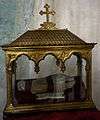Mansuetus (bishop of Toul)
| Mansuetus | |
|---|---|
| Bishop of Toul | |
 | |
| Church | Catholic Church |
| Appointed | 365 |
| Term ended | 375 |
| Successor | Amon |
| Sainthood | |
| Feast day | September 3 |
| Venerated in | Catholic Church |
Saint Mansuetus (French: Mansuy) (died 375) was the first Bishop of Toul. He is thought to be of Irish or Scottish origin. After religious studies in Rome, he was sent by Pope Damasus I to evangelize Gaul, becoming the first bishop of Toul in 365.[1][2]
Life
This Christian leader who was rather an itinerant bishop of Belgica primadied at Tullium, and has become a recognized saint, especially invoked for the healing of lepers. his Feast day is celebrated in the Diocese of Toul on September 3 and in Saint Die on 31 August1.[3] The church Saint Peter, which contains the crypt of St. Mansuy and his successor Saint Amon, is outside the walls northwest of the city touloise.
Saint Mansuy and Toul
Although his life has been attested in numerous documents, his life is totally unknown by historical standards. Gauzelin was first to repair the old St. Peter church in the city in the middle of a former cemetery. Then there is a crypt landscape to place the tombs of revered already Mansuy and Amon. Gerard then replaced the modest foundation clerics originally serving place: it installs the monks of the abbey of St. Èvre school appoints the abbot Adam. The abbey whose temporal goods are confirmed by the supreme authority in charge of managing 965 goods and donations, as well as to enhance the worship at the tomb of St. Mansuy. Note that these first sanctifications only obey the rite Toul.
The oldest Life of St. Mansuy was written by Adson, schoolmaster at the Abbey Saint Epvre of Toul, in the 10th centuryduring the translation of the relics of the bishop by St. Gerard, although this hagiography appears purely legendary.
Penetrating Gaul from the second century, Christianity moved into the frames of administrative life as it existed. These are the divisions of the time of Diocletian who gave the name of the Diocese to the first group of Christians. This was particularly true of Toul, capital Leuques, the diocesan territory followed the outline of the Roman district.
Veneration
According to the Vita Sancti Gerardi, Bishop St. Gerard I of Toul (r. 963–994) had the relics of both Mansuetus and Aprus brought into Toul and placed in the church of St. John the Baptist while he was ill.[4]
His feast day is celebrated on September 3.
Gallery
- Église Saint Mansuy de Fontenoy-le-Château.
 Statue.
Statue. Reliquaire.
Reliquaire. Son gisant.
Son gisant.
Iconography is found on the shrine of Vittel and a brotherhood statue, belonging to the Church of Fontenoy-le-Château. There are parish churches dedicated to St. Mansuy, in Bouvron, Fontenoy-le-Château, Loisey-Culey, Nancy, Serécourt. The village of Dommary-Baroncourt had a church of that name, but itwas destroyed in 1974.
Notes
- ↑ Dictionnaire d'orfèvrerie, de gravure et de ciselure chrétiennes, (Jacques Rémi A. Texier, 1863).
- ↑ « Ils sont nos aïeux, les saints de chez nous » - Chanoine André Laurent - Mirecourt - 1980.
- ↑ Calender Ecclesiatica.
- ↑ Karl Leyser, Timothy Reuter, Warriors and Churchmen in the High Middle Ages: Essays Presented to Karl Leyser (Continuum International Publishing Group: 1992), 56.